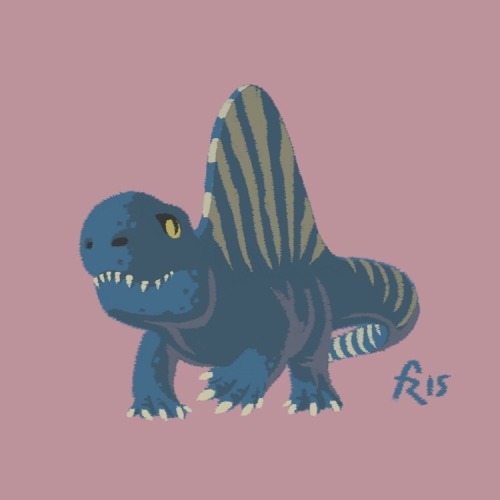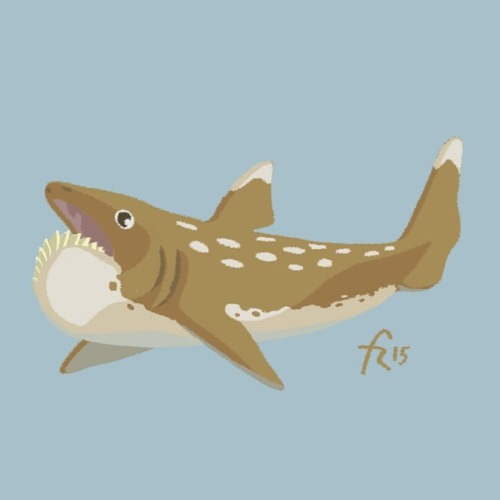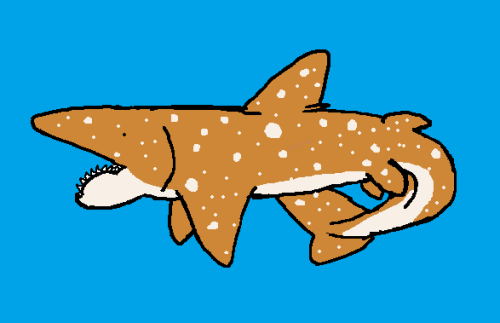#helicoprion

Out of the Blue: How Animals Evolved from Prehistoric Seas
Devonian period (419 to 359 mya): the age of fish! Bony fish, jawless fish, placoderms, sharks, etc.
By Elizabeth Shreeve and illustrated by Frann Preston-Gannon
Helicoprion- Middle Permian (290 Ma)
For someone who loves fish as much as I do, I rarely talk about them here. This is only the third fish I’ve drawn for this blog, and this one wasn’t even my idea. This animal was requested by @mrultra100, who also suggested the color scheme! This one was really fun to research and pretty challenging to draw (in a good way), so thanks for the suggestion! This was a widespread, cartilaginous fish found on every major continent except Africa and Antarctica. This was prime Pangea time, so there was really only one ocean anyway, the Panthalassa. Even though it looks like a shark, it belongs to an extinct order called Eugeneodontida, whose closest living relatives are chimaeras. That’s why the color scheme is based on the spotted ratfish.
The most famous and immediately different feature of Helicoprion is the tooth whorl in the lower jaw. Almost all Helicoprionfossils consist of only these swirly teeth, and a lot of what we know about its appearance is based on its relationship with ratfish and an extinct cousin called Ornithoprion. Since there’s absolutely nothing else with a sharp swirly thing on it alive today, it took a long time to figure out what we were looking at when we dug them up. In the past, it’s been suggested as:
- A part of the upper jaw, curling up over the snout.
- The end of the tail, normally curled but could be lashed at predators.
- A really weird dorsal fin as some kind of defense. Not a very good one, but still.
- The lower jaw, curled downward out of its mouth.
The last interpretation was considered correct for a long time, until partial remains in 2013 revealed it was contained entirely in its jaw. This version looks really really cool and I almost considered drawing it like that instead, but that would be a betrayal of my mission statement, I think. On the plus side, that means this was a much bigger animal than we thought. We have no direct evidence of the shape of its body, but if our estimates are right, it could have been up to 30 feet long. That’s bigger than any non-filter feeding shark alive today.
Since we don’t really know what the whole fish looked like, we can only guess what it used the tooth whorl for, exactly. We know that teeth would grow on the end towards the throat, pushing older teeth into the spiral. We think these were the only teeth in its mouth, and that it used this line of teeth to crush prey against the roof of its mouth. Back when we thought things had to go extinct for a reason, we thought Helicoprion died out because the tooth whorl was too unwieldy. Even though this theory was unpopular long before we knew where exactly the whorl was, knowing that it’s definitely inside its mouth completely discredits the idea that it was too clumsy.
Everything we know for sure about Helicoprion shows how jury-rigged every living animal on earth is. The spiral of constantly growing teeth sounds absolutely ridiculous, especially compared to modern cartilaginous fish whose teeth are arranged like we’re used to, and just replace themselves when they fall out. The tooth whorl evolved in Helicoprion because, well, it was clearly doing something useful for it. There are other, seemingly more straightforward ways to go about crushing things with your jaws, but this lineage just happened to have a string of circumstances (or lack of circumstances) leading to the infamous swirly mouth. We can’t say for sure why that is. Natural selection is complicated, and not everything evolves because it helps something survive. Plenty of traits evolve because there’s no pressure against that trait. Other traits evolve because of the mating preferences of female members of a species. There are a lot of potential reasons for the tooth whorl, but something as unusual and derived as this likely evolved because it served a good purpose.
That’s about it for this mysterious fish. I hope I did a good job, it’s not every day I get a recommendation, and I wanted to go all-out! I did what I could with our limited understanding.
******************************************************************************
Buy me a Coffee, if you’d like!
Post link










